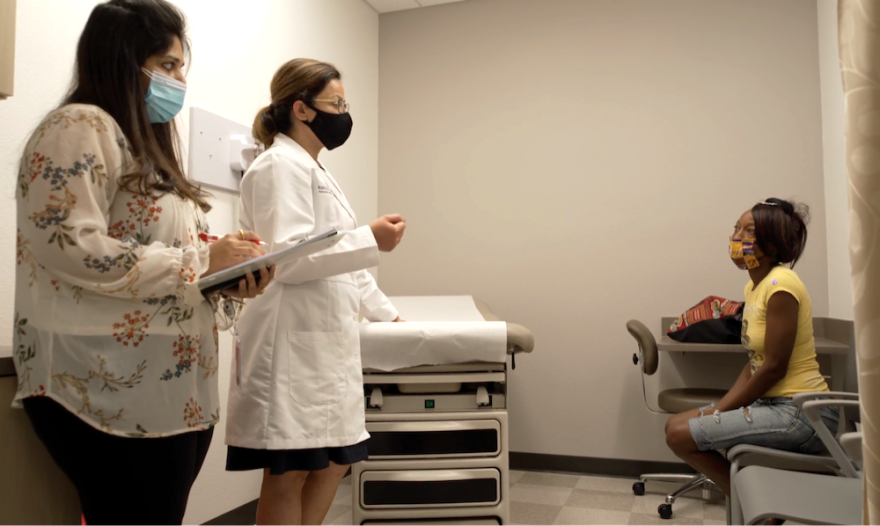This interview was originally broadcast during the January 15, 2021 episode of Science Friday. You can find the original piece here.
Anna Antonowich is an avid rockhound: She knows where to find petrified wood, amethyst, opals, crystalline clusters of Desert Rose, and Nevada’s other gemstones. In July 2019, Antonowich and her sister were rockhounding in Washoe Lake, southeast of Reno, Nevada, when they encountered gusty winds, strong enough to pelt them with rocks and sand.
Three days later, Antonowich started to feel short of breath. She brushed it off as allergies or a bout of asthma, and decided to go on a planned solo backpacking trip a week later. But as she hiked up nearly 11,000 feet, a feat she can normally take in stride, she felt like she couldn’t breathe.
“I was like, this is crazy. I’m in good physical shape for my age,” says Antonowich, who is 62 years old and a nurse practitioner now working at an oncology clinic in Fort Bragg, California. The day after her backpacking trip, she began to have rigors, where the body gets shaking chills.
“It feels like you have an earthquake in your bones.”

For months, Antonowich experienced a persistent fever, dizziness, and chills. In December 2019, Antonowich was diagnosed with valley fever, a respiratory illness caused by breathing in the fungus Coccidioides, which commonly grows in arid regions of the western United States, Mexico, and Central and South America.
In these desert hot spots, communities are now facing what doctors at Kern Medical’s Valley Fever Institute in Bakersfield, California are calling a “triple threat”: COVID-19, valley fever, and the flu.
Rasha Kuran, infectious diseases physician and associate director of the Valley Fever Institute, says distinguishing between influenza and COVID-19 has been challenging enough. “But for us here, it’s three things instead of two.”
Most valley fever patients have symptoms similar to the cold or flu—some can even clear the disease without knowing they had it at all. But in others, it can manifest into a long term, disseminated illness, where the fungus leaves the lungs and invades the rest of the body. In rare cases, valley fever can cause death. There are certain groups that are at higher risk of getting severe disease, including people who are immunocompromised, Filipino, and Black.
Arthur Charles, a Bakersfield resident who was diagnosed with valley fever in 2017, is one of those high risk patients. Charles is still battling valley fever—continuing to take his antifungal medications—and the pandemic has not made it any easier. Earlier last year, he was scared when one of his sons got COVID-19.
“If he touched the doorknob, my wife was behind him with Clorox and Lysol,” Charles says. “She made sure that I stayed clear of all of this, because the last thing I needed on top of valley fever is COVID-19.”

Antonowich wasn’t as fortunate. In March of 2020, shortly after she finally recovered from valley fever, she was infected with COVID-19. Her symptoms began with diarrhea, a bad sore throat, and loss of taste and smell. She lives alone and by day three, she says, “I was afraid to go upstairs for the bed, because I may not be able to come back down again.”
Because valley fever is already a commonly misdiagnosed disease, clinicians are now concerned the pandemic could further delay proper diagnosis. Without a diagnostic test, its initial symptoms can be difficult to distinguish from COVID-19 or flu, Kuran says. “Despite being very different, in terms of valley fever being a fungal infection, and influenza and SARS-CoV-2 being viruses, they do present very similarly.”
COVID-19 and valley fever may both be respiratory illnesses, but there are key differences: coronavirus is contagious, valley fever isn’t. The body’s immune system has specific immune cells for handling viral and fungal infections, explains Katrina Hoyer, associate professor at University of California, Merced, who studies valley fever. “There are different immune cells that are important for each of these types of infections, but there’s also a lot of overlap in what those immune responses look like,” she says.

This can also complicate treatment. In Antonowich’s case, she was tested for and diagnosed with COVID-19. She started feeling better, and thought she was in the clear. But then, her symptoms came back.
“Boom, the shortness of breath hit again,” she says. At first, her doctors were uncertain if the symptoms were from the COVID-19 or if the valley fever might have come back. They were able to determine it was COVID-19 and she received further treatment.
Doctors have identified a few symptoms that likely distinguish COVID-19 from valley fever—typically, a sore throat, and loss of smell and taste are indicators of COVID-19. But if you live in a valley fever hot spot, you might want to also rule out a fungal infection by getting tested, says Arash Heidari of Kern Medical’s Valley Fever Institute.

So far, doctors at Kern Medical say that co-infections of valley fever and COVID-19 are rare—the odds of getting both diseases simultaneously are low. While they have had some patients with both infections, the doctors are still trying to understand if patients with severe valley fever are at higher risk of having complications with COVID-19.
“Getting valley fever, at least to our understanding, will not make you more susceptible to get COVID,” Heidari says, but adds that there haven’t been enough cases of co-infection to fully assess what’s going on in the immune system. Doctors are advising patients with histories of valley fever to take extra precautions during the pandemic.
Valley fever numbers are expected to be lower in 2020 than previous years, Heidari adds. That’s because wearing masks and staying indoors to stop the spread of COVID-19 may be helping decrease valley fever infections, too. But Heidari is concerned that the low numbers might also be from data reporting issues and people’s reluctance to go to the doctors’ office to get tested during the pandemic.
“We might get higher than average cases next year, when people come up with complications after the fact.”

Katrina Hoyer at UC Merced has similar concerns. The pandemic has slowed down her valley fever research. She’s shifted toward data analysis that she could still do during the shutdown, but some of her projects have come to a standstill altogether.
“I basically just wrote my progress report to the NIH and had to explain why we have no data for them over the year,” she says. “This is true for pretty much everything that’s not COVID-related. We are not making progress on other diseases right now. I’m concerned about what that’s going to do for the other health problems that we have to deal with when we get through COVID.”
As for Anna Antonowich, she has since recovered from COVID-19, and hasn’t had any additional relapses. However, some of the impacts on her lungs have lingered. “I still have times now where my breath catches. I’ll be talking to a patient, and all of a sudden, I can’t breathe,” Antonowich says.
Her experience with valley fever and COVID-19 has caused her to modify her behavior. “If I’m out in the wind rockhounding, I wear a mask. I’m more careful that way,” Antonowich says, but adds, “I don’t want to live my life in fear of what I’ve been through. As soon as my lungs allow, I’ll be back mountain biking and backpacking.”
Further Reading
- Listen to a radio feature and conversation about valley fever research and patients, by Science Friday and KVPR.
- Explore a multimedia feature about Arthur Charles and valley fever researchers on Methods, from Science Friday.
- Listen to patients and loved ones tell their experiences with valley fever in a Science Friday article.
- Find more information about COVID-19 and valley fever symptoms at Kern Medical’s Valley Fever Institute.
- Read a report by Kern Medical doctors that details the case of a patient with both COVID-19 and valley fever, published in Journal of Investigative Medicine High Impact Case Reports.
- Read a story about the “triple threat” on healthcare and communities in The Bakersfield Californian.
- Read a story by KVPR’s Kerry Klein about the Avenal State Prison inmates who were infected with valley fever.

